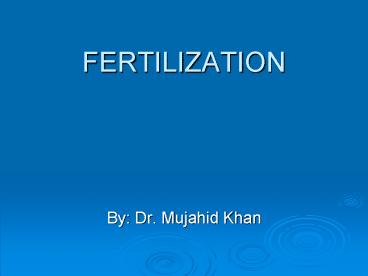FERTILIZATION - PowerPoint PPT Presentation
1 / 30
Title:
FERTILIZATION
Description:
FERTILIZATION By: Dr. Mujahid Khan Fertilization Is a complex sequence of coordinated molecular events Begins with a contact between sperm and ovum Ends up with ... – PowerPoint PPT presentation
Number of Views:1197
Avg rating:3.0/5.0
Title: FERTILIZATION
1
FERTILIZATION
- By Dr. Mujahid Khan
2
Fertilization
- Is a complex sequence of coordinated molecular
events - Begins with a contact between sperm and ovum
- Ends up with intermingling of maternal and
paternal chromosomes
3
Site
- Usual site is the ampulla of uterine tubes
- Ampulla is the longest and widest part
- If the oocyte is not fertilized here, it slowly
passes to the uterus, where it degenerates and
absorbed - Fertilization may occur in other parts of uterine
tubes
4
Site
- Does not occur in the uterus
- Chemical signals from oocyte attract the gamete
specific proteins on the surface of the sperms - The fertilization process takes about 24 hours
5
(No Transcript)
6
Phases of Fertilization
- Passage of sperm through corona radiata
- Penetration of zona pellucida
- Fusion of the plasma membrane of the oocyte and
sperm - Completion of second meiotic division formation
of female pronucleus - Formation of male pronucleus
7
Passage of Sperm Through Corona Radiata
- Dispersal of the follicular cells of the corona
radiata surrounding the oocyte and zona pellucida - This results mainly from the action of
hyaluronidase enzyme released from the acrosome - Tubal mucosal enzymes also appear to assist in
dispersal
8
(No Transcript)
9
Penetration of Zona Pellucida
- Passage of a sperm through the zona pellucida is
the important phase in the initiation of
fertilization - The enzymes estrases, acrosin and neuraminidase
appear to cause lysis of zona pellucida - Forming a path for the sperm to follow the oocyte
10
Penetration of Zona Pellucida
- Zona reaction occurs once the sperm penetrates
the zona pellucida - It makes zona pellucida impermeable to other
sperms - The composition of this extracellular
glycoprotein coat changes after fertilization
11
(No Transcript)
12
Fusion of the Plasma Membrane of the Oocyte and
Sperm
- The plasma membranes of the oocyte and sperm fuse
and break down at the area of fusion - The head and tail of the sperm enter the
cytoplasm of oocyte - Sperms plasma membrane remains behind
13
Completion of Second Meiotic Division
- Penetration of the oocyte by a sperm activates
the oocyte into completing the second meiotic
division - Mature oocyte and a second polar body are formed
- Nucleus of the mature oocyte becomes a female
pronucleus
14
Formation of Male Pronucleus
- Cytoplasm of oocyte and nucleus of the sperm
enlarges to form the male pronucleus - Tail of the sperm degenerates
- Morphologically the male and female pronuclei are
indistinguishable - The oocyte containing two haploid pronuclei is
called an ootid
15
Formation of a Zygote
- As the pronuclei fuse into a single diploid
aggregation of chromosomes, the ootid becomes a
zygote
16
Early Pregnancy Factor
- Is an immunosuppressant protein
- Secreted by trophoblast
- Appears in maternal serum within 24-48 hrs
- It forms the basis of a pregnancy test during the
first 10 days of development
17
(No Transcript)
18
Chromosome
- Zygote is genetically unique
- Half of chromosomes from father and half from
mother - New combination is formed which is different from
either of parents - This mechanism forms biparental inheritance and
variation of human species
19
Sex of the Embryo
- Embryo's chromosomal sex is determined at
fertilization - Sex is determined by the type of sperm (X or Y)
fertilizes the oocyte - It is father whose gamete decides the sex
20
Results of Fertilization
- Stimulates the penetrated oocyte to complete 2nd
meiotic division - Restores the normal diploid number of chromosomes
- Determines chromosomal sex of embryo
- Initiates cleavage (cell division) of zygote
21
Cleavage of Zygote
- Consists of repeated mitotic divisions of zygote
- Rapid increase in the number of cells
- These smaller embryonic cells are called
Blastomeres - Normally occurs in the uterine tube
22
Cleavage of Zygote
- Zygote divides first into 2 then 4 and 8
- Zygote is within the thick zona pellucida during
cleavage - Zona pellucida is translucent under light
microscope - Begins about 30 hrs after fertilization
23
(No Transcript)
24
Compaction
- Blastomere change their shape after 9 cell stage
- Tightly align themselves against each other
- Form a compact ball of cells
- Probably mediated by cell surface adhesion
glycoprotein - Permits greater cell to cell interaction
25
(No Transcript)
26
Morula
- When there are 12-32 blastomeres the developing
human is called MORULA - Enters the uterus at this stage
- Spherical morula forms about 3 days after
fertilization - Has outer and inner cell layer
- Resembles mulberry or blackberry
27
Formation of Blastocyst
- Morula enters the uterus 4 days after
fertilization - A fluid-filled space called the blastocystic
cavity appears inside the morula - The fluid passes from the uterine cavity through
the zona pellucida to form this space
28
Formation of Blastocyst
- Blastomere is separated into two parts as the
fluid increases in the blastocystic cavity - A thin outer cell layer called trophoblast
- Inner cell mass that gives rise to embryo called
embryoblast
29
(No Transcript)
30
(No Transcript)































